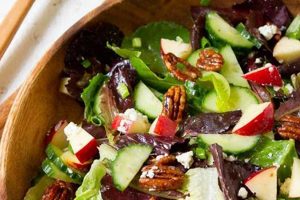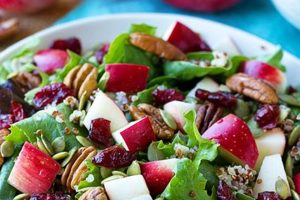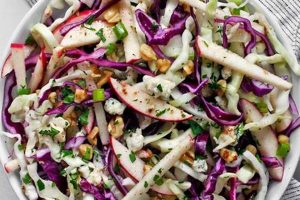A refreshing and healthful alternative to traditional versions, this type of salad features apples as the central ingredient, combined with various complementary components but omits mayonnaise. Typical additions might include other fruits like grapes or cranberries, vegetables such as celery or carrots, nuts, and a light dressing made with ingredients like yogurt, vinegar, or citrus juice. A simple example could involve diced apples, chopped celery, toasted walnuts, and a lemon-vinaigrette.
This style of salad offers several advantages. By foregoing mayonnaise, the dish becomes significantly lower in fat and calories while retaining the nutritional benefits of the fruits and vegetables. This makes it a suitable option for those seeking healthier dietary choices. The absence of mayonnaise also contributes to a lighter, brighter flavor profile, allowing the natural sweetness and tartness of the apples to shine through. Furthermore, these salads tend to hold their texture better than mayonnaise-based versions, remaining crisp and fresh even after some time. Historically, fruit salads predate the widespread use of mayonnaise, and this approach represents a return to simpler preparations.
Further exploration will cover variations on the basic recipe, including different apple varieties, ingredient combinations, and dressing options. Tips for preparation and storage will also be addressed to ensure optimal flavor and texture.
Tips for Apple Salad without Mayonnaise
The following tips provide guidance for creating optimal apple salads that exclude mayonnaise, focusing on ingredient selection, preparation techniques, and storage.
Tip 1: Apple Selection: Opt for firm, crisp apple varieties such as Honeycrisp, Fuji, or Braeburn. These varieties hold their shape well and offer a balance of sweetness and tartness.
Tip 2: Preventing Browning: To prevent cut apples from browning, toss them immediately with a small amount of lemon juice or an acidic dressing. This inhibits enzymatic oxidation.
Tip 3: Balancing Flavors: Combine apples with complementary ingredients. Consider incorporating ingredients with contrasting textures and flavors, such as crunchy celery, toasted nuts, or dried cranberries.
Tip 4: Dressing Choices: A light vinaigrette made with apple cider vinegar, olive oil, and a touch of honey or maple syrup complements apples well. Yogurt-based dressings also offer a creamy texture without the heaviness of mayonnaise.
Tip 5: Ingredient Incorporation: Add more delicate ingredients, like leafy greens or grapes, closer to serving time to prevent them from becoming soggy or bruised.
Tip 6: Storage: Store leftover salad in an airtight container in the refrigerator for up to two days. For optimal texture, store the dressing separately and toss it with the salad just before serving.
Tip 7: Enhancing Flavor Complexity: A sprinkle of cinnamon, ginger, or nutmeg can enhance the flavor profile, particularly during the autumn and winter months.
By following these guidelines, one can consistently create flavorful, healthful, and visually appealing apple salads without relying on mayonnaise.
These practical tips facilitate the creation of salads that are not only delicious but also contribute to a balanced diet. The following section offers concluding remarks and encourages culinary experimentation.
1. Fresh, Crisp Apples
The foundation of a successful apple salad without mayonnaise rests upon the selection of fresh, crisp apples. Their texture and flavor contribute significantly to the overall quality of the dish. Choosing the right variety and understanding proper handling ensures a delightful culinary experience.
- Variety Selection
Specific apple varieties offer optimal characteristics for salads. Honeycrisp, known for its sweetness and juicy crunch, provides a pleasant textural contrast. Fuji apples offer a balanced sweetness and firmness, holding their shape well even after being sliced. Braeburn, with its tart-sweet flavor profile, adds a refreshing dimension. Selecting varieties based on desired flavor and textural profiles is paramount.
- Crispness and Texture
Crispness indicates freshness and contributes to the salad’s appeal. Apples that are mealy or soft detract from the overall experience. The satisfying crunch of a fresh apple enhances the enjoyment of the salad. Maintaining crispness requires proper storage and handling techniques.
- Flavor Profile
The apple’s flavor profile plays a crucial role in balancing the other ingredients. Sweet apples pair well with tangy dressings and savory additions. Tart apples provide a refreshing contrast to creamy or nutty components. Considering the interplay of flavors within the salad ensures a harmonious result.
- Preventing Oxidation
Apples are prone to browning due to enzymatic oxidation when exposed to air. To maintain their fresh appearance and prevent discoloration, several techniques can be employed. Tossing the sliced apples with a small amount of lemon juice or an acidic dressing creates a protective barrier against oxidation. This preserves the apples’ visual appeal and maintains their fresh flavor.
The selection, handling, and variety of fresh, crisp apples directly impact the final quality of an apple salad without mayonnaise. By understanding these factors, one can create a salad that is both visually appealing and palate-pleasing, showcasing the natural flavors and textures of this versatile fruit.
2. Complementary Ingredients
Complementary ingredients play a crucial role in elevating apple salad recipes without mayonnaise beyond simple fruit dishes. These additions contribute textural complexity, enhance flavor profiles, and offer nutritional balance. Careful consideration of ingredient pairings ensures a harmonious and satisfying culinary experience.
Textural contrast is essential. Crunchy elements such as celery, walnuts, or pecans provide a counterpoint to the apple’s texture. Soft ingredients like grapes or dried cranberries offer a different mouthfeel. The interplay of these textures creates a more dynamic and engaging sensory experience. For instance, the crispness of celery complements the softer texture of apples, while toasted walnuts introduce a satisfying crunch.
Flavor pairings contribute depth and complexity. Sharp cheeses, such as cheddar or crumbled blue cheese, offer a savory counterpoint to the apple’s sweetness. Dried fruits like cranberries or raisins introduce concentrated sweetness and a chewy texture. Herbs and spices, such as mint, tarragon, or cinnamon, can accentuate the apple’s natural flavor or add a contrasting note. A salad combining apples, crumbled blue cheese, walnuts, and dried cranberries exemplifies a balanced flavor profile.
Nutritional balance is another benefit derived from complementary ingredients. Leafy greens, such as spinach or kale, boost the salad’s vitamin and mineral content. Protein-rich additions like grilled chicken or chickpeas create a more substantial meal. These additions enhance the nutritional value while complementing the apple’s inherent nutritional properties. Adding grilled chicken and spinach to an apple salad increases its protein and nutrient content, transforming it into a balanced meal.
Successful ingredient selection hinges on understanding flavor affinities and textural compatibility. Apples pair well with ingredients that offer contrasting or complementary flavors and textures. Experimentation and careful consideration of these factors lead to well-balanced and flavorful salads. Overly sweet additions may clash with the apple’s natural sweetness, while ingredients with similar textures may result in a monotonous mouthfeel.
3. Light, flavorful dressing
Light, flavorful dressings are essential to successful apple salads without mayonnaise. They provide flavor complexity, moisture, and textural contrast while maintaining a healthy profile. The absence of mayonnaise necessitates a dressing that compensates for the lack of richness and creaminess while complementing the apples’ natural sweetness and tartness.
A vinaigrette, typically composed of oil and vinegar, offers a classic foundation. Apple cider vinegar, with its subtle sweetness and tang, harmonizes particularly well with apples. The oil component contributes richness and helps distribute flavors throughout the salad. A touch of honey or maple syrup can be added for extra sweetness, while Dijon mustard provides a subtle sharpness. For example, a simple vinaigrette of apple cider vinegar, olive oil, honey, and Dijon mustard creates a balanced, flavorful dressing.
Yogurt-based dressings offer a creamy alternative without the heaviness of mayonnaise. Greek yogurt provides a tangy base, while the addition of herbs, spices, or citrus zest enhances the flavor profile. A dressing made with Greek yogurt, lemon zest, and a pinch of dill complements apples beautifully. These dressings also contribute to the salad’s overall nutritional value.
The choice of dressing significantly impacts the final flavor profile and overall balance of the salad. Overly sweet or heavy dressings can mask the delicate flavors of the apples and other ingredients. The dressing should complement rather than overpower the other components, enhancing the overall sensory experience. A well-chosen dressing elevates the apple salad from a simple combination of ingredients to a cohesive and flavorful dish.
4. Proper Apple Preparation
Proper apple preparation is crucial for an apple salad without mayonnaise. It ensures optimal texture, prevents discoloration, and maximizes the fruit’s contribution to the overall dish. Correct techniques enhance both the visual appeal and the culinary experience.
- Selection and Handling
Choosing firm, crisp apples is essential. Avoid bruised or damaged fruit. Gentle handling minimizes bruising and maintains structural integrity. Apples should be washed and thoroughly dried before use.
- Slicing and Dicing
Uniformity in cutting ensures even distribution of flavor and texture throughout the salad. Consistent bite-sized pieces contribute to a more pleasant eating experience. The method of cutting can also influence visual presentation.
- Preventing Oxidation
Apples are susceptible to enzymatic browning upon exposure to air. Tossing cut apples with an acidic agent, such as lemon juice or a light vinaigrette, inhibits this process. This maintains the apple’s fresh appearance and prevents discoloration.
- Timing of Preparation
Preparing apples close to serving time minimizes oxidation and preserves texture. If advance preparation is necessary, storing cut apples in an airtight container with a small amount of acidic liquid helps maintain freshness.
These preparation steps contribute significantly to a successful apple salad without mayonnaise. Careful attention to selection, handling, cutting, and oxidation prevention maximizes the apple’s contribution to the salad’s overall quality, ensuring a visually appealing and flavorful dish.
5. Balanced Flavor Profiles
Balanced flavor profiles are essential for a successful apple salad without mayonnaise. The absence of mayonnaise, a dominant flavor in traditional versions, necessitates careful consideration of the interplay between sweetness, tartness, acidity, and other flavor components to create a harmonious and satisfying culinary experience. A well-balanced flavor profile elevates the salad beyond a simple combination of ingredients, transforming it into a cohesive and nuanced dish.
- Sweetness and Tartness
The inherent sweetness of apples forms the foundation of the flavor profile. Balancing this sweetness with tartness is crucial. Tart apples, like Granny Smith, offer a natural counterpoint, while the tartness of other ingredients, such as cranberries or a vinaigrette dressing, can also achieve this balance. Overly sweet salads can be cloying, while overly tart salads can be unpleasantly sharp. The interplay between these two elements creates a dynamic and refreshing flavor profile.
- Acidity and Salt
Acidity enhances the other flavors and provides brightness. Lemon juice or vinegar in the dressing introduces acidity, balancing the sweetness and adding a refreshing tang. A touch of salt enhances the sweetness and other flavors, creating a more complex profile. The careful balance of acidity and salt prevents the salad from becoming bland or overly sweet.
- Textural Considerations
Texture plays a significant role in perceived flavor. Crunchy elements like nuts or celery offer a contrasting texture to the apples, enhancing the overall sensory experience. The interplay of textures contributes to a more dynamic and satisfying flavor profile. A salad with uniform texture can be monotonous, while varied textures create a more interesting and engaging dish.
- Complementary Ingredients
Ingredients like cheese, herbs, and spices introduce additional flavor dimensions. Sharp cheddar provides a savory note, while fresh mint adds a refreshing herbal element. A sprinkle of cinnamon or nutmeg complements the apple’s sweetness, particularly in autumnal variations. These additions create a multi-layered flavor profile, enhancing the complexity and overall enjoyment of the salad.
Achieving a balanced flavor profile in an apple salad without mayonnaise requires careful consideration of the interplay between these different elements. The absence of mayonnaise allows the inherent flavors of the apples and other ingredients to shine through, making balance even more critical. By understanding these principles, one can create a salad that is not only healthy and refreshing but also offers a complex and satisfying flavor experience.
6. Optimal storage techniques
Optimal storage techniques are essential for maintaining the quality and extending the lifespan of apple salad without mayonnaise. Because this type of salad lacks mayonnaise, which acts as a preservative and textural stabilizer in traditional versions, it is more susceptible to enzymatic browning, textural degradation, and flavor changes. Proper storage mitigates these effects, preserving the salad’s freshness, crispness, and overall appeal.
Several factors contribute to quality degradation in stored apple salads. Exposure to air accelerates enzymatic browning, causing the apples to discolor. Temperature fluctuations can lead to textural changes, making the salad soggy or mushy. Absorption of flavors from other foods in the refrigerator can also negatively impact the salad’s taste. For example, an uncovered apple salad stored near onions will likely absorb the onion’s pungent aroma. Practical application of optimal storage techniques addresses these challenges directly. Storing the salad in an airtight container minimizes air exposure, reducing browning. Maintaining a consistent, cool temperature inhibits bacterial growth and preserves texture. Storing the dressing separately prevents the salad from becoming soggy and allows for individual flavor adjustments just before serving.
Effective storage strategies preserve the intended sensory experience of the apple salad. The crispness of the apples, the brightness of the dressing, and the overall balance of flavors are maintained through proper storage. Neglecting these practices compromises the salad’s quality, diminishing its appeal. Understanding and implementing these techniques is therefore crucial for anyone seeking to enjoy the full benefits and intended flavors of an apple salad without mayonnaise, maximizing both its shelf life and culinary enjoyment.
Frequently Asked Questions
This section addresses common inquiries regarding apple salad recipes without mayonnaise, providing concise and informative responses.
Question 1: How can browning be prevented in apple salads without mayonnaise?
Apples brown due to enzymatic oxidation upon exposure to air. Tossing cut apples with an acidic liquid, such as lemon juice or a vinaigrette containing vinegar, inhibits this process.
Question 2: What are suitable apple varieties for salads without mayonnaise?
Firm, crisp varieties like Honeycrisp, Fuji, and Braeburn hold their shape well and offer a balance of sweetness and tartness. These varieties are less likely to become mushy or discolored.
Question 3: What dressings can replace mayonnaise in apple salads?
Light vinaigrettes made with apple cider vinegar or other flavorful vinegars, along with yogurt-based dressings, provide suitable alternatives to mayonnaise. These options reduce fat content while offering complementary flavors.
Question 4: How long can apple salad without mayonnaise be stored?
Properly stored in an airtight container in the refrigerator, apple salad without mayonnaise typically lasts for up to two days. Storing the dressing separately can extend shelf life and maintain crispness.
Question 5: What ingredients complement apples in mayonnaise-free salads?
Ingredients like celery, grapes, walnuts, dried cranberries, and cheeses such as cheddar or blue cheese offer complementary textures and flavors, enhancing the overall complexity of the salad.
Question 6: Can apple salads without mayonnaise be made ahead of time?
While best served fresh, these salads can be prepared a few hours in advance. Storing cut apples with a small amount of acidic liquid and adding more delicate ingredients just before serving helps maintain optimal quality.
Understanding these aspects facilitates the creation of flavorful and visually appealing apple salads that prioritize freshness and health-conscious choices.
This concludes the frequently asked questions section. The following section will offer a summary of key concepts and concluding remarks.
Conclusion
Exploration of this salad variation reveals a versatile and healthful approach to enjoying a classic dish. Emphasis on fresh, crisp apples as the central ingredient, combined with carefully selected complementary components and a light, flavorful dressing, yields a salad that prioritizes both flavor and nutritional value. Proper preparation techniques, including preventing enzymatic browning and maintaining textural integrity, contribute significantly to the final product’s quality. Optimal storage practices further ensure the salad’s longevity and preserve its intended flavors and textures.
This approach represents a shift toward health-conscious culinary practices without sacrificing flavor or satisfaction. The versatility of this salad allows for endless variations, encouraging culinary creativity and exploration of diverse flavor profiles. Embracing this approach offers a pathway to enjoying a refreshing and nutritious salad that aligns with contemporary dietary preferences.






